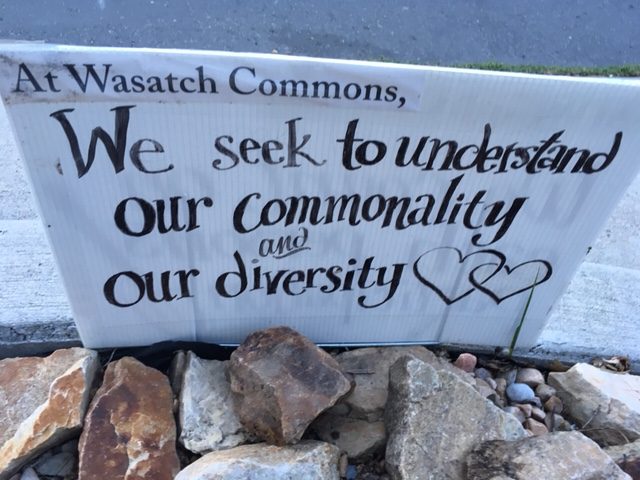Cohousing Across the Country – Part 6

Sharing the journey from Atlanta, GA to Anacortes, WA, engaging with community along the way.
Part 6 of 7
Wasatch Commons
My final stop on my cohousing tour, was with Wasatch Commons in Salt Lake City. It seemed fitting to end my visits with one of the longest standing communities in the US. Wasatch recently celebrated 20 years of life together. That long history of working together shows in so many ways.
As we were arranging my visit, it turned out that the guest rooms were already claimed. Not to worry, the abundance of community tends to provide, and so it was that Mom and I were welcomed into a private home with lots of beautiful natural light, a spacious feel and a gracious host.
I thoroughly enjoyed our tour of the property. The layers of time were evident everywhere. I imagined that the multiple playgrounds met the needs of different generations of children. The expansive garden spaces were a mix of shared and personal spaces, the sort of balance that arrives after decades of working and re-working relationships. I particularly liked the scaffolding for the peas which has clearly had a previous life as a jungle gym.
The best part of the visit was, of course, the gathering of the community. They gathered a rare Monday night potluck to match my schedule. After feasting on summer produce, we gathered in the cozy common house fireside room for a conversation about community, communication and the challenges that come with both.
It is always a profound privilege and joy to sit with a community and bear witness a they share their challenges and explore what it means to be sharing relationship with one another. As one of the pioneer communities in the US, Wasatch is now experiencing the transition that I believe all communities will experience as they age.
As communities form, they find ways to coexist with differences, they build trust, and they create the processes and habits that make community work. And then, over time, many of those original people leave the community and new folks come in. To some extent new folks choose to join the community because it fits them, and to some extent they are integrated into community as they arrive. At the same time both new community members and the growth and changes in long-term members bring new differences into the community. They disrupt the equilibrium and create shifts in identity. It tends to happen slowly over time, but bit by bit, it becomes clear that there is a need to address again the challenges the community faced when they first formed, with a few twists.
Who are we now? How do we balance welcoming new whole people with holding our identity as a community? What do we do when new ideas feel threatening or old habits feel constricting? As we celebrate all we are and have been, how do we also lean in to what we will be? How do we honor both the vision and labor of our founders and the ideas and energy of our new members? What will give us the sense of strong connection that we all crave?
Being conscious of these shifts, taking time to get curious about these concepts and play with various answers is the first step toward the next phase of thriving community. It was an honor to be with members of Wasatch Commons as they leaned into that work and the vulnerability it requires. It was a beautiful example of community that was at once thriving and challenged, rich and incomplete, constant and ever-changing. This, for me, is the beauty of community. It gives me hope for our future, and energy for the road ahead. It was the perfect way to wrap up my cross-country tour.
Category: transitions
Tags: middle age, multigenerational, new members, transition
Views: 1505

